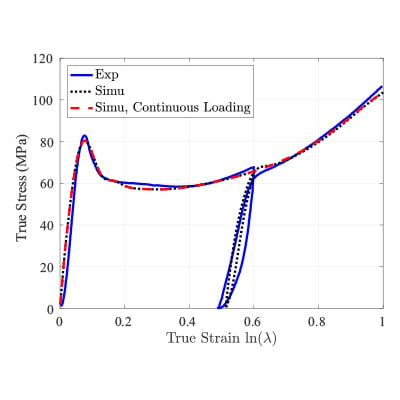
Our group has strong interests in developing nonlinear constitutive theories for the nonequilibrium, viscoelastic, and viscoplastic behavior of polymers and polymer composites.
Amorphous polymers
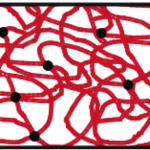 Amorphous polymers have a wide-range of complex time-dependent and temperature-dependent behavior. At high temperatures, amorphous polymers exhibit an elastomeric, viscoelastic solid, or viscoelastic fluid-like behavior. At low temperatures, below the glass transition temperature, the materials are stiff and exhibit rate-dependent and temperature-dependent yielding, strain softening, and orientation hardening.
Amorphous polymers have a wide-range of complex time-dependent and temperature-dependent behavior. At high temperatures, amorphous polymers exhibit an elastomeric, viscoelastic solid, or viscoelastic fluid-like behavior. At low temperatures, below the glass transition temperature, the materials are stiff and exhibit rate-dependent and temperature-dependent yielding, strain softening, and orientation hardening.
Our research aims to
- Develop coupled continuum thermomechanical theories that can capture the full extent of the nonequilibrium behaviors of polymers. We do this by applying the effective temperature concept to describe the glass transition, physical aging, mechanical rejuvenation, and the large deformation viscoelastic behavior.
- Apply the models to study the mechanical properties of thermoplastic parts 3D printed by melt extrusion.
- Apply the models to study the contribution of the viscoplastic behavior on the fracture toughness of the weld between two adjacent printed lines.
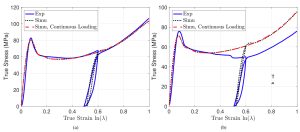
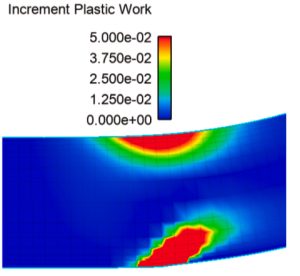
Figure 1: The viscoplastic stress response of polycarbonate to loading, unloading, and reloading at two different strain rates (a) 0.001/s and (b) 0.0001/s comparing experiments and simulations. (c) Contour of the incremental plastic work at the crack tip of a peel specimen showing large dissipation at the crack tip and point of maximum bending.
Ultrahigh Molecular Weight Polyethylene Fibers
UHMWP fibers have a heterogenous microstructure that includes oriented fibrillar crystalline domains, folded lamellar crystalline domains, and entangled amorphous domains. The fibers are also populated by defects, such as voids. We propose to develop experimentally validated micromechanical models for the rate-dependent and temperature-dependent inelastic behavior to study how these morphological features determine the strength and toughness of polymer fibers at different deformation rates and temperatures. This will guide the development of constitutive models for the inelastic behavior of the fibers. We are developing computational micromechanical models that integrate data from fiber-level experimental efforts and lower scale atomistic modeling efforts to determine the fiber morphology and mechanical properties of the constituent domains.
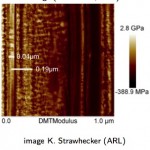
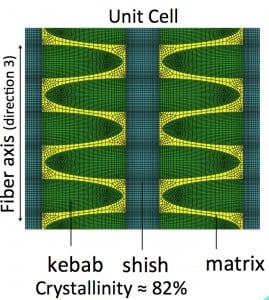
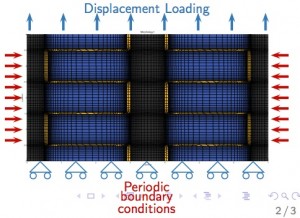
Figure 2: (a) Atomic force microscope (AFM) image of the shish-kebab microstructure of UHMWP fibers, courtesy of ARL; (b) micromechanical model of the representative volume element of the shish-kebab structure; (c) Periodic boundary conditions of the micromechanical model.
Collaborators
- Mark O. Robbins, Ph.D. Professor, Department of Physics and Astronomy, Johns Hopkins University
- Kevin J. Hemker, Ph.D., Professor, Department of Mechanical Engineering, Johns Hopkins University
- Jonathan E. Seppala, Ph.D., Staff Scientist, Polymer Processing Group, National Institute of Standards and Technology
- Kalman Migler, Ph.D., Staff Scientist, Polymer Processing Group, National Institute of Standards and Technology
- David Kazmer, Ph.D., Professor, Department of Plastics Engineering, University of Massachusetts, Lowell

